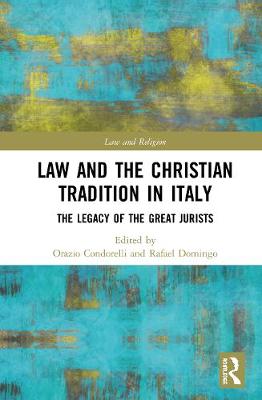
Law and the Christian Tradition in Italy edited by Orazio Condorelli and Rafael Domingo
Review by John Witte Jr.
This volume is part of a 50-volume series on “Great Christian Jurists in World History,” presenting the interaction of law and Christianity through the biographies of 1000 legal figures of the past two millennia. Commissioned by the Center for the Study of Law and Religion at Emory University, each volume in this series focuses on a specific country, region, or era, and it samples the life and work of a score or more of its greatest legal minds over the centuries. These legal minds include not only civil and canon lawyers and judges but also theologians, philosophers, and church leaders who contributed decisively to legal ideas and institutions, or who helped create landmark statutes, canons, or cases. Thus, familiar Christian jurists like Gratian, Grotius, Blackstone, Kuttner, and Scalia appear in this series, but so do Augustine, Isidore, Aquinas, Calvin, Barth, Maritain, and Romero. This biographical approach is not intended to deprecate institutional, doctrinal, social, or intellectual histories of law, nor will it devolve into a new form of hagiography or hero worship of dead white males. It is instead designed to offer a simple method and common heuristic to study the interaction of law and Christianity around the world over the past two millennia.
Columbia University Press opened this series in 2006 with a three-volume work on Modern Christian Teachings on Law, Politics, and Human Nature, featuring thirty modern Catholic, Protestant, and Orthodox Christian figures. Cambridge University Press has new titles on great Christian jurists in the first millennium, as well as in English, Spanish, French, Lowlands, and American history. Routledge is taking up the Italian, Nordic, Russian, Welsh, and Latin American stories; Mohr Siebeck the German story; Federation Press the Australian story. Forthcoming titles will cover great Christian jurists in the history of Scotland, Ireland, Austria, Switzerland, Greece, and various countries and regions in Eastern Europe, the Middle East, Africa, and Asia.
“Thrice has Rome conquered the Western world,” Rudolf von Jhering once wrote: “by her arms, by her church, and by her law.” Another volume in this series analyzes the first of these conquests, and the shaping influence of the ancient Roman Empire on law and religion in the first millennium Western world. This volume takes up the second and third of these “conquests” – the transformative power of the Roman church and Roman law on the Italian peninsula (“Italy” today) in the second millennium. Italy was the initial site of the “papal revolution” when Pope Gregory VII (r. 1073-85) and others established the Roman Catholic Church as the preeminent legal and political ruler of medieval Christendom. Italy was the site of the rebirth of Roman law when scholars rediscovered the Digest of Justinianin ca. 1070 and created the first law faculties in Bologna, Padua, Naples, and Siena dedicated to its intense study and new application in statutes and cases. Italy was also the site of the rebirth of the Church’s canon law with the publication of Gratian’s Decretum in ca. 1140 unleashing a massive new industry of church legislation and canonical jurisprudence, built in part on Roman law prototypes. And Italy was the birthplace of scholastic theology and philosophy, catalyzed by the rediscovery of Greek, Roman, and patristic sources and brought to sublime expression in the monumental Summae of Thomas Aquinas and others.

This Italian story of birth and rebirth in law and religion repeats itself in the middle of the second millennium. The Italian renaissance brought the world more than breathtaking new art, architecture, and literature, based in part on classical Roman prototypes. It also brought the Church comprehensive reforms and renewals of its doctrine, liturgy, catechesis, and governance set out in the monumental decrees of the Council of Trent (1546-63), the church’s definitive response to Protestant and other reform movements in Christendom. The Tridentine decrees also transformed the canon law, leading to the publication of the Roman edition of the books of the Corpus Iuris Canonici in 1582 and the (re)establishment of canon law faculties and methods in many major universities around Italy and well beyond. The Renaissance renewed Roman law and civilian learning both through application of the famous mos gallicus method to numerous public, private, penal and procedural law questions and through publication, with the new printing press, of masterful new legal treatises, the best of them gathered in the massive Tractatus universi juris of 1584 issued under the auspices of Pope Gregory XIII. And this was the time of a brilliant neo-Thomist renaissance in theology, philosophy, and jurisprudence, led more centrally by the University of Salamanca in neighboring Spain, but also transformative of legal, political, and social scholarship in many Italian universities.
And rebirth and renewal in law and religion recur yet again at the end of the second millennium. The Catholic Church, badly shaken by the attacks of modern liberalism and sharply divided across a vast new colonial empire, responded with another renewal of Thomistic thought in the sweeping new social teachings movement inaugurated by Pope Leo XIII and culminating in the constitutions, declarations, and decrees of the Second Vatican Council (1962-1965) a century later. The Church transformed its canon law with the promulgation of a new Code of Canon Law, first in 1917 and again in 1983, reviving anew deep canon law jurisprudence, now regularly taught in seminaries and law faculties. Renewal and reform of state law came with the great legal codification movements of the 19th and 20th centuries, the constitutional transformation of Italy in the grim aftermath of Mussolini and two world wars, and the negotiation of a whole series of brilliant new concordats between the Holy See and Italy and various nation-states in Europe and the Middle East.
This volume tells this millennium-long story of law and religion in Italy through a series of 26 well-chosen and well-written biographical case studies. The chapters range from the first Italian civilians and canonists, Irnerius and Gratian in the early twelfth century to the leading architect of the Second Vatican Council, Pope Paul VI. Between these two book ends, we get exquisite case studies of familiar civilians like Bartolo, Baldo, and Gentili and familiar canonists like Hostiensis, Panormitanus, and Gasparri but also a number of other distinguished jurists who deserve much more attention today from non-specialists. A few famous popes and cardinals who shaped the law, Innocent IV, Cajetan, Bellarmine, and Paul VI make an appearance on these pages. So do a few theologians and philosophers with profound legal insights and reforms, such as Aquinas, Vico, and Sturzo. But most of the case studies focus on canon law and civil law jurists – judiciously selected from the 2159 jurists who appear in the two-volume biographical dictionary of Italian jurists (Dizionario biografico dei giuristi italiani, 2013), and collectively represent the major schools and shifts in thought about the multiple interactions of law and Christianity over the second millennium. And almost all the case studies feature devout Catholics who dominate the religious landscape of Italy until the twentieth century when creative free-thinkers begin to reconstruct and reform traditional teachings yet again.
The editors of this volume are both leading European legal historians. Orazio Condorelli is Professor of Ecclesiastical and Canon Law in the University of Catania, Italy and an author of more than 150 articles and several books, including an authoritative five-volume collection on the influence of medieval canonists on the development of European legal culture. Rafael Domingo is Spruill Family Professor of Law and Religion at Emory and Alvaro d’Ors Professor of Law at the University of Navarra, Spain, who has published a score of volumes, including series titles on great Christian jurists in Spanish, French, and Latin American history (forthcoming). This volume on Italian jurists includes an all-star cast of legal historians from Europe and North America who have contributed fresh chapters, written in authoritative and accessible style. The chapter authors include R.H. Helmholz (University of Chicago), Olivier Descampes (Pantheon-Assas University, Paris), and Wim Dekock (KU Leuven) who are editors of other series volumes on great Christian jurists in the history of England, France, and the Lowlands (forthcoming). ♦

John Witte Jr., JD (Harvard); Dr. Theol. h.c. (Heidelberg), is Robert W. Woodruff Professor of Law, McDonald Distinguished Professor of Religion, and director of the Center for the Study of Law and Religion at Emory University. A specialist in Legal History, Human Rights, Religious Freedom, Marriage and Family Law, Law and Religion, he has published 280 articles, 17 journal symposia, and 35 books.
Recommended Citation
Witte, Jr., John. “Law and the Christian Tradition in Italy edited by Orazio Condorelli and Rafael Domingo – Review by John Witte, Jr. Canopy Forum, June 4, 2020. https://canopyforum.org/2020/06/04/review-law-and-the-christian-tradition-in-italy/

